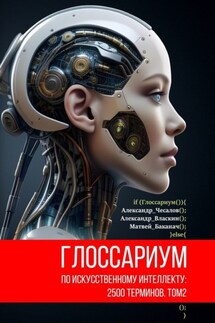Глоссариум по искусственному интеллекту: 2500 терминов. Том 2 - страница 41
Embodied cognitive science is an interdisciplinary field of research, the aim of which is to explain the mechanisms underlying intelligent behavior. It comprises three main methodologies: 1) the modeling of psychological and biological systems in a holistic manner that considers the mind and body as a single entity, 2) the formation of a common set of general principles of intelligent behavior, and 3) the experimental use of robotic agents in controlled environments455.
Empirical risk minimization (ERM) – choosing the function that minimizes loss on the training set. Contrast with structural risk minimization456,457.
Encoder in general, is any system that converts from a raw, sparse, or external representation into a more processed, denser, or more internal representation. Encoders are often a component of a larger model, where they are frequently paired with a decoder. Some Transformers pair encoders with decoders, though other Transformers use only the encoder or only the decoder. Some systems use the encoder’s output as the input to a classification or regression network. In sequence-to-sequence tasks, an encoder takes an input sequence and returns an internal state (a vector). Then, the decoder uses that internal state to predict the next sequence. Refer to Transformer for the definition of an encoder in the Transformer architecture458.
Encryption is the reversible transformation of information in order to hide from unauthorized persons, while providing, at the same time, authorized users access to it459,460.
End-to-end digital technologies is a set of technologies that are part of the digital economy: big data, neurotechnologies and artificial intelligence, distributed registry systems, quantum technologies, new production technologies, industrial Internet, robotics and sensor components, wireless communication technologies, virtual and augmented reality technologies461.
Energy Efficiency – from both economic and environmental points of view, it is important to minimize the energy costs of both training and running an agent or model.
Ensemble averaging in machine learning, particularly in the creation of artificial neural networks, is the process of creating multiple models and combining them to produce a desired output, as opposed to creating just one model462.
Ensemble is a merger of the predictions of multiple models. You can create an ensemble via one or more of the following: different initializations; different hyperparameters; different overall structure. Deep and wide models are a kind of ensemble463.
Enterprise Imaging has been defined as «a set of strategies, initiatives and workflows implemented across a health- care enterprise to consistently and optimally capture, index, manage, store, distribute, view, exchange, and analyze all clinical imaging and multimedia content to enhance the electronic health record» by members of the HIMSSSIIM Enterprise Imaging Workgroup464.
Entity annotation – the process of labeling unstructured sentences with information so that a machine can read them. This could involve labeling all people, organizations and locations in a document, for example465.
Entity extraction is an umbrella term referring to the process of adding structure to data so that a machine can read it. Entity extraction may be done by humans or by a machine learning model









